Abstract
Recent motivation to cut greenhouse gas emissions to combat climate change has led to increasing transportation electrification. However, electric vehicle proliferation comes with a number of challenges such as battery capacities and the range anxiety of electric vehicles. In this paper, a review of the main components that affect electric vehicle adoption, which are charging infrastructure and energy resources, is presented. We discuss the categories of electric vehicle charging infrastructure, based on the location-of-charge and the charging technology. In addition, a review of the energy resources required for electric vehicles is also presented. The key features of these batteries are also discussed.
1. Introduction
Electric vehicles (EVs) are fast becoming a popular substitute to internal combustion engine (ICE) vehicles due to their ability to reduce air pollution and greenhouse gas emissions [1]. A growing number of countries are making plans to phase out ICEs in the near future [2,3]. Electric vehicles have an electrified powertrain, energy storage systems, and extremely efficient electric motors [4]. Economic research by the Japanese company Fuji forecasts the number of worldwide EV sales to reach 22.02 million in 2035 [5]. However, EVs have problems such as expensive batteries, long duration to recharge, limited number of available stations for electric charging, power system issues, and range anxiety. The battery costs for small passenger electric vehicles could reach almost one third of the overall cost of the EV [6,7]. In relation to range anxiety, the “300-mile mantra” has become a repetitive concern for a lot of prospective EV users. According to a Consumer Reports study, 49% of the 3323 respondents requested at least a 300-mile recharge range for their electric vehicles [8]. A large majority, or roughly 63%, anticipated a minimum shifting range of 250 miles. Other research has also reported the “300-mile mantra” and estimates that with about 1% of urban road electrification, EVs could comfortably achieve the 300-mile range [9,10]. As a result, it has become an unofficial benchmark for range anxiety diminution.
Charging infrastructure is key to an increased adoption of EVs. An increased distribution of potential charging locations could ease the anxiety of potential EV users and encourage their purchase of EVs. In acknowledgement of this, governments and entities have attempted policies and measures to bridge the EV infrastructure gap to facilitate EV adaption. Through policies, the Norwegian government has heavily invested in the growth of charging infrastructure to increase the adoption of EVs since 2009 [10]. In addition, the US Bipartisan Infrastructure Bill makes USD 7.5 billion available for EV charging infrastructure development. This aims to provide 500,000 publicly accessible chargers throughout the US with universal compatibility for all vehicles by 2030 [11].
In this paper, a review of electric vehicle charging infrastructure is presented. We discuss the various classifications, research, and trends within this area. EV charging infrastructure, categorized mainly into two areas—by location-of-charge and by charging technology/technique—is presented and thoroughly discussed. In addition, the advantages and drawbacks of these categories are also discussed. Furthermore, in this work, various charging schemes for both wired and wireless electric vehicle charging infrastructure and their advancements are laid out. In addition, a review of the energy resources required to power electric vehicles is also presented. The key features of these resources are also discussed. This work provides information that could benefit other researchers interested in electric vehicle charging infrastructure and development. Figure 1 summarizes the structure of the review presented in this paper. The advancement and trends within these areas are exhaustively presented and discussed. The information presented in this review could be used as a reference for other research within the area of EV infrastructure and energy resources.
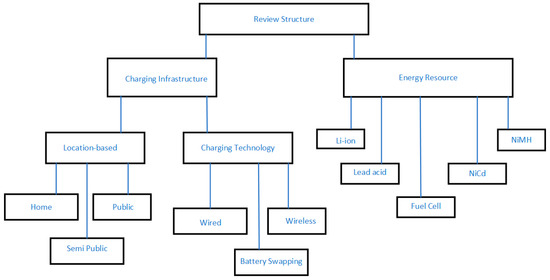
Figure 1.
Structure of review.
The next sections are organized as follows. First, the electric vehicle charging infrastructure is introduced in Section 2, and all the categories of the infrastructure are thoroughly discussed. Then, the various energy resources needed for EV applications are presented in Section 3. The future prospects of EV charging infrastructure towards increased EV adoption are laid out in Section 4, and the conclusion is made in Section 5.
2. Electric Vehicle Charging Infrastructure
With the world’s shift towards clean energy and the concerted efforts to reduce greenhouse emissions to combat climate change, electric vehicles are rapidly becoming the alternative to fuel-based internal combustion engine vehicles. It is estimated that the transportation sector alone accounted for 25% of the greenhouse gases in energy-related sectors in 2009 [12,13]. Efforts are, therefore, being made to reduce these emissions from the vehicular fleet and EV penetration into the transportation sector is at the forefront of this drive. In [12], the Institute of Energy Agency (IEA) reports that electric car registrations increased by 41% in 2020, despite the COVID-19 pandemic inducing a drop in the worldwide vehicle sales by 16%. In addition, the report describes a rise in EV sales by over 140% during the first quarter of 2021 as compared to the same period in 2020. These numbers indicate the increased penetration of EVs into the modern vehicular fleet and an increased attractiveness of EVs. Data from [14] show a steep increase in EV models with light-duty EV manufacturers offering more models in the market. This trend is shown in Figure 2.
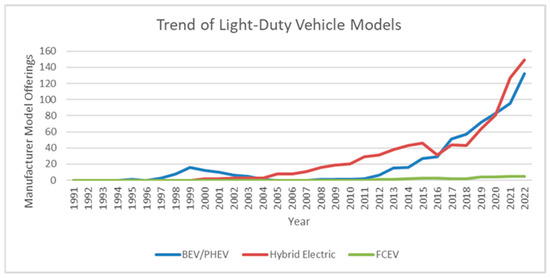
Figure 2.
Yearly trends of EV models offered by vehicle manufacturers from 1991 to 2022.
EV penetration, however, has not been without problems. Notable among these are range anxiety due to relatively less available charging infrastructure as compared to ICEs [6]. This has been one of the most important limiting factors for faster EV adoption. Increased investment in charging infrastructure is key to solving this problem and increasing the adoption of EVs. This section expansively presents the available charging infrastructure types and other research carried out within this area. Before this, however, we first review various electric vehicles.
Generally, EVs can be divided into four main types [15]:
- Battery electric vehicle;
- Hybrid electric vehicles;
- Plug-in hybrid electric vehicles;
- Fuel cell electric vehicles.
2.1. Battery Electric Vehicles
Battery electric vehicles (BEVs) are also known as all-electric vehicles (AEV). These vehicles have battery packs that are their only source of energy. The only contribution of these vehicles to pollution depends on the energy source that power the charging station—whether it is clean energy or not—since they have no tailpipe emissions. They are, therefore, classified as zero-emission vehicles [16].
2.2. Hybrid Electric Vehicles
Hybrid electric vehicles (HEVs) run on a combination of an ICE and one or more electric motors that draw power from batteries. The batteries in these EVs charge using regenerative braking by harnessing the energy that is lost during braking in vehicles. HEVs can either be mild or full hybrids, with series or parallel configuration. Mild EVs can allow the engine to shut off when the car comes to a halt, and utilize a battery and electric motor to power the vehicle. Full hybrid vehicles have relatively larger batteries and can power the EV over short distances at low speeds. Mild hybrids have the advantage of lower cost over their full hybrid counterparts, whilst full hybrids provide more savings on fuel and their batteries can power the EV, albeit over short distances [14].
2.3. Plug-In Hybrid Electric Vehicles
Plug-in hybrid electric vehicles (PHEVs) are similar to HEVs in that they have two sources to power the vehicle. However, unlike HEVs, PHEVs charge their batteries by being plugged in to external power sources. The contribution of a PHEV to pollution is directly proportional to the amount of time the EV operates in full electric mode or on gasoline [16].
2.4. Fuel Cell Electric Vehicles (FCEVs)
Fuel cell electric vehicles (FCEVs) utilize hydrogen as their source of energy. They employ fuel cells to produce electric power using compressed hydrogen gas stored in highly pressured tanks and have an efficiency of about 60%, as compared to the 20–30% of ICEs [17]. Like BEVs, FCEVs are zero-emission vehicles, with their contribution to pollution from the source of hydrogen production, which may be from a clean energy or not. Therefore, FCEVs combine the zero emissions of BEVs with the fast refueling time of ICE vehicles. According to the IEA, global deployments of FCEVs was up by 13% in 2021 to over 1 million vehicles [18].
The proportion of these types of EVs according to data from [14] is shown in Figure 3, with FCEVs being by far the smallest category of EVs available currently. Examples of these types of EV models are provided in Table 1.
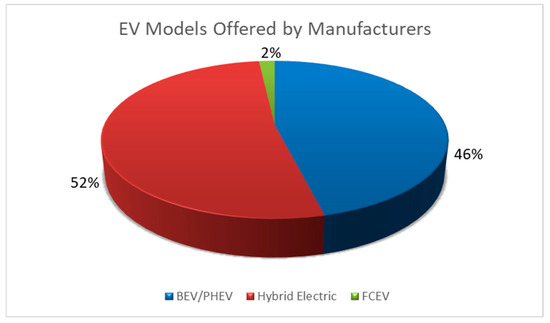
Figure 3.
Proportion of various EV models available on the market.

Table 1.
Types of EVs and their popular examples.
2.5. Classification of Charging Infrastructure Based on Location-of-Charge
Based on the location-of-charge of the charging infrastructure, we identify three main categories of charging facilities. Each of these facilities has different characteristics and different levels of charging. An overview of the infrastructure classification is shown in Figure 4.

Figure 4.
Classification of EV charging infrastructure.
2.5.1. Home/Residential/Private Facilities
Residential facilities are currently the most common areas with highest EV penetration. These facilities are built and owned by individuals or entities and are dedicated for personal use or for use of an EV fleet owned by the individuals or entities. These chargers are located in personal homes, parking lots in apartments, and special areas dedicated by the entities. The chargers utilized for these types of facilities are usually level 1 or level 2 chargers. This is because they have the advantage of time convenience. An EV user could have about 8 h to fully charge the EV, although level 1 chargers are slow chargers. This saves costs insofar as faster and more expensive chargers are not needed. Although more expensive, Plugless Power [19] has developed a modular static wireless charger that could be installed for use in homes.
2.5.2. Semi-Public Facilities
These are found in universities, malls, hospitals, and government offices, and accessible only to EV users patronizing or working in these places. The chargers utilized in these areas are usually level 1 and level 2, although some malls have fast chargers available. Aside from these chargers, wireless chargers may also be available in these areas. An example is the dynamic wireless charging system developed by KAIST on their campus [9].
2.5.3. Public Facilities
Public charging infrastructure can be found in areas accessible to everyone such as dedicated areas around parks, petrol stations, public parking lots, and even on roads. Public charging facilities have the highest penetration of fast and superfast charging facilities due the relatively less time spent in these areas as compared to the home or residential areas. Furthermore, the various types of wireless charging have a higher availability in this category than the other two areas (home and semi-public). This is because wireless charging techniques are more expensive and they require a relatively larger space, especially in the case of dynamic and quasi-dynamic wireless charging.
2.6. Classification of Charging Infrastructure Based on Charging/Refueling Technology
2.6.1. Wired Electric Vehicle Charging
Initial charging infrastructure for EVs was based on conductive charging. This charging infrastructure makes use of charging cables to charge the EVs. These are usually located in garages in the homes of owners, in offices, and in a few outdoor areas. This model requires a long charging time for a substantial charge of the battery to be acquired. In addition, EVs charged using this means require relatively larger battery sizes, which increases the weight and cost of the EV. EVs that use conductive charging could either be BEV or PHEV.
Conductive charging is either AC or DC. The AC charging infrastructure has two levels, with the third level still in development. Current fast chargers are DC level 3 chargers. Tesla’s DC level 3 charger, the supercharger, has an estimated charging rate of up to 1000 miles per hour for Model 3 [20]. Apart from the Tesla supercharger, other DC fast charging standards are the combined charging system (CCS), GB/T, and the CHAdeMO [21,22]. The CHAdeMO standard is used in Japan, whereas the GB/T is the DC fast charging standard in China. The CCS is the main standard in the US, Europe, and the rest of the world. However, these different standards are increasingly being adopted in different regions outside their main regions. The connectors for the various charging system are shown in Figure 5.

Figure 5.
EV charger connecter types (a) J1772, (b) Tesla, (c) CCS, (d) CHAdeMO, (e) GB/T [17,23].
Table 2, Table 3 and Table 4 summarize the characteristics of AC and DC level chargers [24,25]. It is worth noting that AC level 3 chargers are not fully developed and, therefore, level 3 chargers usually refer to DC level 3 chargers. Table 5 gives examples of different EVs that use DC fast charging [21,22,26].

Table 2.
Characteristics of AC level chargers.

Table 3.
Characteristics of DC level chargers.

Table 4.
AC and DC level connectors and their charging speeds.

Table 5.
Charging standards and their key manufacturers.
Publicly available chargers have increased at an impressive rate over the last few years. Table 6 shows data from publicly available slow and fast chargers in selected countries. Furthermore, the impressive rate of increase in EV public charger infrastructure is depicted in Figure 6 and Figure 7.

Table 6.
Publicly available EV chargers as of 2021 [27].
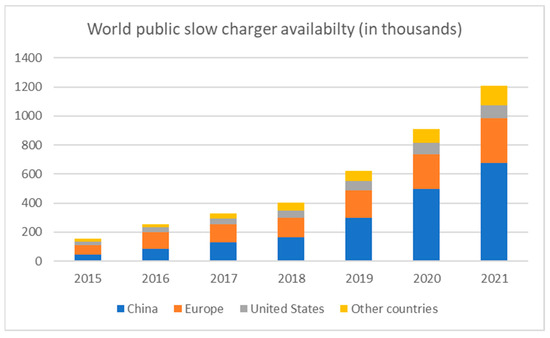
Figure 6.
Publicly available slow charger availability in recent years [27].
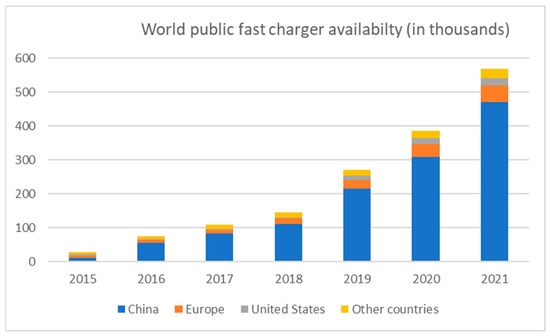
Figure 7.
Publicly available fast charger availability in recent years [27].
2.6.2. Wireless Electric Vehicle Charging
The most common form of technique-based charging, the wired form of charging, still retains EV problems such as time consumption, inconvenience in the use of wired chargers, and the need for larger batteries, which increases the EV weight as well as cost. Wirelessly charging EVs could resolve some of the problems associated with plug-in electric vehicles. Wireless charging can reduce the high cost of large batteries through the utilization of relatively smaller batteries, and solve range anxiety problems [9,28,29]. It is also very safe and a more convenient way of charging since it eliminates the cables used in plug-in EVs. Wireless charging systems utilize wireless power transfer technology, which is based on inductive resonant coupling [30].
Wireless charging of EVs could be classified into static [28,31,32,33], dynamic [29,32,34], and quasi-dynamic [9,35]. Another form of classification uses the distance of travel of the field, either near-field (inductive, magnetic resonance coupling, and permanent magnet coupling) or far-field (microwave, laser) [29]. Under this classification, the most common of these techniques is inductive wireless charging. This is because it has no resonant circuit involved [36] and is less bulky as compared to magnetic resonance coupling systems, making it easier to be installed at the bottom of EVs.
In static charging, EVs are wirelessly charged while parked close to the charging piles or over the charging platform as shown in Figure 8. Static wireless charging has the advantage of being situated in convenient and smaller areas such as parking lots and garages. However, the EVs that use this type of charging require large capacities of batteries, which increases the cost of the EV. This is because battery cost is a major contributor to the rise in EVs’ price [6,7,9,37]. In addition, a major advantage it has over conductive charging models is the lack of contact between the transmitter and receiver, therefore improving the power supply transfer efficiency. Static wireless charging is the most popular wireless charging principle. This type of wireless charging performs better because there is better alignment between the power transmitters and the receivers of the EV [29]. In September 2020, an Israeli company, Electreon, successfully installed a static wireless charging system at the Tel Aviv University train station bus terminal to charge the buses when they stop at the terminals [38]. Moreover, Plugless Power has achieved several milestones in the field of static wireless charging. It has developed 3.3 kW and 7.2 kW wireless charging systems, which are available for purchase [19]. Plugless Power is also in the process of producing the first wireless charging stations for the Tesla Model S EVs. The main disadvantage of static wireless charging is that it still requires EVs to have large onboard batteries and it takes a substantial amount of time to charge enough for a long travel distance.
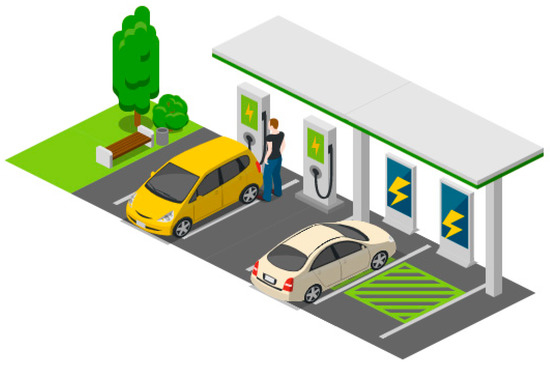
Figure 8.
Wired charging (left) and static wireless charging (right) of EVs.
Dynamic wireless charging involves charging the EV while it is moving on the road. In DWC, charging modules and pads are built underneath the roads to transfer power to the moving vehicles through wireless technology. This invariably provides convenience and reduces range anxiety, which are key factors in the increase in acceptance of electric vehicles. Furthermore, with the ability to charge while driving, the need for large batteries for electric vehicles could be eliminated, which would significantly reduce the cost of the electric vehicles. The online electric vehicle system, created by the Korean Institute of Science and Technology, is a dynamic type of wireless charging technology that is commercially available. The first online electric vehicle system was created in 2009, and a second online electric vehicle system was created in 2012 for a bus shuttle system on the Korean Institute of Science and Technology campus [37]. INDUCTEV has also developed a 300 kW dynamic wireless charging system with an efficiency of 90% that is available commercially [39]. One of the major drawbacks of the DWC is the very high cost of initial investment for installing the charging infrastructure [9]. Another problem with dynamic wireless charging is the efficiency of the power transfer as a result of coil misalignments and the size of the charging pads [29]. Furthermore, the maintenance costs of the charging pads can be high. Figure 9 shows the process of DWC of an EV.
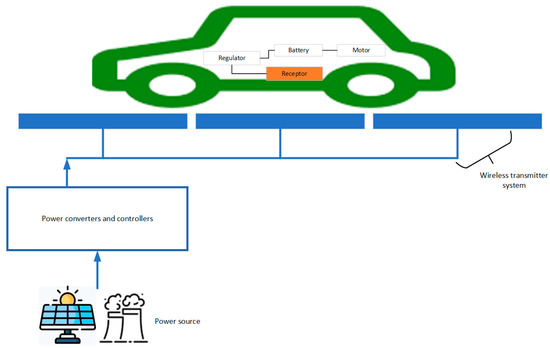
Figure 9.
Schematic of dynamic wireless charging of EVs.
Quasi-dynamic wireless charging is a relatively newer approach compared to SWC and DWC. In QWC, the electric vehicles are designated to charge for brief moments in traffic stops or at bus stops [40].
QWC is sometimes referred to as static en route charging. This charging strategy aims to find a trade-off between the advantages and disadvantages of both the SWC and DWC. In theory, it is expected that this would eliminate range anxiety while reducing the total amount spent on the charging infrastructure. There have been a few research projects investigating the area of QWC [9,29,35]. In [35], a QWC model is proposed for a grid-to-vehicle and V2G power transfer. The research in [9] presents a cost analysis for the initial investment costs for SWC, DWC, and QWC. The QWC, as a result of its qualities, could leverage the benefits of both the SWC and the DWC while minimizing their downsides. In using QWC, the very high investment costs for building the charging infrastructure for DWC, as well as the maintenance costs of the infrastructure, could be minimized. As a result, the benefits achievable through QWC include convenience and reduced investment costs, battery sizes, and EV purchase costs.
Advances in Electric Vehicle Wireless Charging
Several research works have been conducted towards making the EV experience worthwhile. The major reason for the advance of wireless charging of EVs is to provide more convenience and improve the range anxiety issues for EV owners. These various research works have focused mainly on improving the range anxiety phenomenon and reducing the total costs of EV operation. These could be grouped under optimization-based solution models and non-optimization-based solution models. Several optimization-based models have been reported in the literature. Some of these models have focused on route scheduling, as in [41,42]. In [41], Zhang et al. explored a charging scheme to minimize system operation costs for an electric bus that is charged through wireless charging. Initially, the average speeds of the buses were presumed and based on this, a scheduling algorithm was formulated. Other optimization models focused on the placement and determining the size of EV charging infrastructure. In [43], a network of multiple roads is considered. The system is modelled as a nonlinear program (NLP) with a multi objective function solved using particle swarm optimization. This optimization model aimed to find the best compromise between the battery costs and infrastructure costs. However, the battery state-of-charge model presented is too complex. The model also assumes that the batteries of the EVs are all fully charged at the start of the journey. The optimal siting issue is resolved in [44] by reducing the number of charging stations. The performance of this model is assessed under power flow constraints. Even though electrical power flow equations are non-linear, the power flow constraints were modelled as oversimplified linear models, which could affect the accuracy of the model. The optimal allocation of charging stations and distributed generation resources in a power network is presented in [45]. With the integration of the charging stations and DGs, the authors also aimed at reducing the losses within the power network. The main drawback with this proposed solution is the manual allocation of the charging stations within the network. This is because, for power networks with many buses, this would be impossible to implement. In [46], a mixed integer model is developed to find the optimal place for DWC services as well as optimally size the batteries for electric buses. The model developed assumed fully charged batteries at the start of every trip. This assumption, however, is highly unlikely in practice. Energy disseminators are employed in [47]. The purpose of these disseminators is to make energy wirelessly available for EVs that need to charge on the road to improve driving range. The approach exploits intervehicular communications to present a routing method for EVs around the disseminators. The EVs that need to charge this way need to move at constant speeds and pace themselves alongside the mobile disseminators in order to gain a substantial charge. As a result, the charging process is slow and the total travel time of the EVs also increases. An integrated EV DWC system is modeled using a multi-stage framework. The design of a scheduling plan for a V2G application and the use of a mixed integer linear programming (MILP) model to allocate power make up this multistage framework [48]. First, an approach for the power tract placement is developed. Then, the dynamic V2G scheduling scheme is formulated. Very few solutions have been provided in non-optimization-based solution models. An IoT-based solution model is presented in [31]. This is a three-layered hierarchical model developed to enable communication between wired charging, SWC, and DWC models. To enable charging reservations, as well as route calculation of autonomous mobility of in-demand trips for connected autonomous EVs, the authors in [31] also propose two message frames. On the other hand, not much focus has been placed on QWC and the potential benefits it could bring in solving problems related to EVs. In [29], Ahmad et al. present a comprehensive study of wireless power transfer principles and the various developments in this field. The paper thoroughly discusses SWC and DWC. However, a brief discussion is of QWC is presented. In [9], the cost analysis of the initial investment in SWC, DWC, and QWC is presented. The objective function of the QWC was attaining a minimum battery storage cost of the EV as well as the charger costs at the base stations. The model included the base station charger costs because the paper assumed that the EVs fully charge at the base stations before they leave. In practice, however, this assumption may not be valid, especially for public bus systems with a smaller fleet that would have little time at the base station. In [35], the feasibility of DWC at traffic stops is explored. The paper discusses fixed and variable charging scenarios of EVs. In the fixed charging study, the BEVs charge at fixed power levels designated at the traffic stops. In the second study, a varying charging rate is permitted depending on the SOC of the EV. Even though this scenario could provide more flexibility than the fixed charging, the battery SOC rate was limited to between 30% and 80%.
Classifications of Wireless Charging Models in the Literature
EV wireless charging research has largely focused on four main areas. These areas are as stated below:
- Optimal allocation and sizing of charging stations;
- Power electronics;
- Communications;
- Optimal scheduling and routing.
In each category, various research has targeted different objectives. In Table 7, a summary of some of the objectives of these research works is presented.

Table 7.
Categories of wireless charging models in the literature.
2.6.3. Battery Swapping Infrastructure
Battery swapping charging infrastructure provides an option for EV users to exchange their expended batteries for recharged batteries. This charging infrastructure reduces the longer charging times associated wired and static wireless charging infrastructure, which could drive the faster adoption of EVs. The major issues plaguing the current low penetration of these stations include the lack of standardization of EV batteries across the world. Other EV users also worry about the potential of exchanging their faultless batteries with faulty ones [58]. The huge cost of investment to purchase and store batteries for these swapping stations is another issue. This played a key part in the USD 1 billion bankruptcy of the US battery swapping startup Better Place [58]. EV market giant Tesla also worried about these issues and the scalability of battery swapping stations, and dropped its battery swapping infrastructure plans after a pilot in California in 2013 [59,60]. The market for this infrastructure is steadily growing with major investment within the last few years, although most of this have been in two- and three-wheelers. To address the standardization problem of battery swapping stations, Gachaco—consisting of Honda, Suzuki, Kawasaki, and Yamaha—has launched a service of replaceable standardized batteries [61].
In relation to four-wheeled vehicle infrastructure, steady progress is also being made, especially in China, with about 1400 stations [58]. The Chinese company Nio is currently leading the battery swapping infrastructure systems for four-wheeled EVs with a successfully implemented system in China. Nio plans to have about 5000 stations around the world, up from 800 stations, by 2025 [58]. Nio, in collaboration with Geely, battery tech maker Aulton, and oil producer Sinopec, intends to expand the battery swapping network to 24,000 stations by 2025 [62,63]. Nio is currently expanding outside China and opened its first battery swapping station in Germany in September 2022 [61]. The US startup Ample have also begun the deployment of swapping stations, with seven stations currently in the US. Plans to expand outside the US are underway, with deployment already beginning in Madrid in collaboration with Uber and Repsol [62].
2.6.4. Hydrogen Refueling Infrastructure
Several governments and agencies are taking steps to improve infrastructure for FCEVs. The H2ME initiative of several EU countries aims to provide over 45 hydrogen refueling stations in anticipation of a mature market for FCEVs by 2025 [64]. Currently, stations in 39 locations are available, with 9 more in development under the H2ME initiative. The US has a substantial number of stations in 55 locations, all in California [14]. With two and one refueling station locations in British Columbia and Quebec, respectively, Canada has a total of five refueling station locations according to US Department of Energy data [14]. This, in comparison with other alternative fuels in the US and Canada, is shown in Figure 10. However, according to [65], which tracks hydrogen refueling stations available worldwide, these numbers are much higher, with up to 685 hydrogen refueling stations available worldwide at the end of 2021 in 33 different countries. The number of these stations in selected countries is shown in Figure 11.
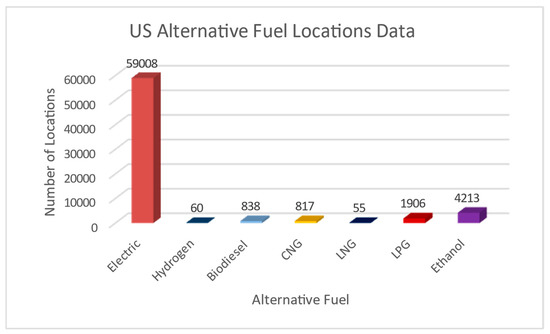
Figure 10.
Number of alternative station locations in the US and Canada.
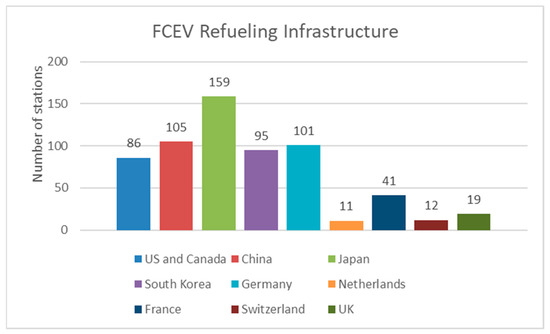
Figure 11.
Hydrogen refueling infrastructure in selected countries.
3. Energy Resources for EV Applications
Electric vehicles could be powered by energy stored in batteries only, as in the case of BEVs, by hydrogen fuel in the case of FCEVs, and a combination of energy from batteries and fossil fuels in the case of HEV and PHEVs. In this section, we focus on the energy resources from batteries and hydrogen, which account for the zero tailpipe emissions of EVs. These classifications are shown in Figure 12.

Figure 12.
Categories of EV energy resources.
Based on their recharging capabilities, batteries can be grouped into primary and secondary batteries. Primary batteries cannot be recharged after being fully discharged, whereas secondaries batteries can be recharged. Therefore, practically speaking, secondary batteries are the obvious choices for EV applications. The most popular batteries used in EV applications are lithium-ion (Li-ion) batteries, nickel-based batteries (nickel metal hydride (NiMH) and nickel cadmium (NiCd)) and lead acid [66].
3.1. Lead Acid
Gaston Planté developed the first lead acid battery in 1859 and it was the first battery to be considered rechargeable. They are produced using grids and electrodes made of lead. Lead oxide, along with the electrolyte, the positive electrode, and the negative electrode, participates in the electrochemical charging or discharging of this battery [67].
3.2. Nickel-Based
3.2.1. Nickel Cadmium
These batteries are made through the deposition of an active material inside a porous nickel electrode. These batteries have the disadvantage of low range and relatively high cost [68]. The plastic containers for Ni-Cd batteries are constructed from polypropylene, polystyrene, and flame-retardant plastics. These are of preference in comparison with other metal-based counterparts. They bring the advantages of high corrosion resistance, less weight, and their electrolyte level can be easily visually managed [66].
3.2.2. Nickel Metal Hydride
The nickel metal hydride is an improved form of the nickel cadmium battery. The cathode is often created through the impregnation or pasting of nickel compounds onto foam nickel or a highly porous sintered substrate, whereas the anode is frequently a nickel foil or grid perforated and covered with a hydrogen storage alloy. These batteries have a comparatively significant improvement in energy density. They are also more environmentally friendly as compared to the nickel cadmium batteries [69,70,71].
3.3. Lithium-Ion
These batteries were introduced in the 1990s, with better advantages of greater range (about thrice that of the lead acid) and a high specific energy [44]. The anode is often a perforated nickel foil or grid coated with a hydrogen storage alloy, whereas the cathode is frequently constructed of a highly porous sintered substrate or foam nickel. Li-ion batteries have a broad operating temperature range (0 to 45 °C for charging and −40 to 65 °C for discharging), a high cycle life (more than 1000 cycles), high efficiency, and a low self-discharge rate (2–8% per month) [66,72].
3.4. Hydrogen Fuel Cell
The US Department of Energy classifies hydrogen as an alternative fuel together with others such as biodiesel, biobutanol, and ethanol [14]. The application of hydrogen in EVs is still in a budding stage compared to other fuel sources, with far fewer FCEVs on the market. This is evident from the comparison of alternative fuel stations shown in Figure 10.
Hydrogen can be produced through several ways such as electrolysis, gasification, steam forming, and fermentation [14,73]. Hydrogen produced through electrolysis has a higher purity of over 99%, as compared to using fossil sources—through gasification and steam forming—of over 90% [73]. Several processes can be used to purify hydrogen for fuel cell (FC) applications, as reported in [74]. The share of sources used for hydrogen production is shown in Figure 13, with fossil fuels making up the overwhelming majority [73].
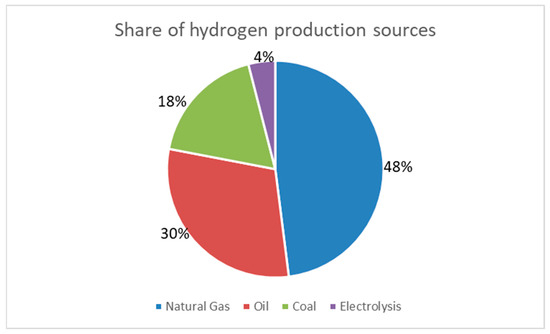
Figure 13.
Share of hydrogen production sources.
The research in [75] identifies six different technologies of fuel cells. These are the alkaline fuel cell, direct methanol fuel cell, molten carbonate solid oxide, phosphoric acid, and polymeric electrolyte membrane (PEM) fuel cell. The PEM is the most common type of FC used in EV applications. An anode, cathode, and electrolyte membrane are components of the FC. By transferring hydrogen via the anode and oxygen through the cathode, it generates an electric current. An electrochemical process takes place in the FC catalyst, causing the hydrogen molecules to split into protons and electrons. While the electrons are propelled through the circuit as an electric current, the protons flow through the porous electrolyte membrane. Protons, electrons, and oxygen mix at the cathode to form water molecules on the cathode side after being compelled to go through an external circuit to power the EV [14,76]. This process is shown in Equations (1) and (2). A simple diagram of a fuel cell is shown in Figure 14.
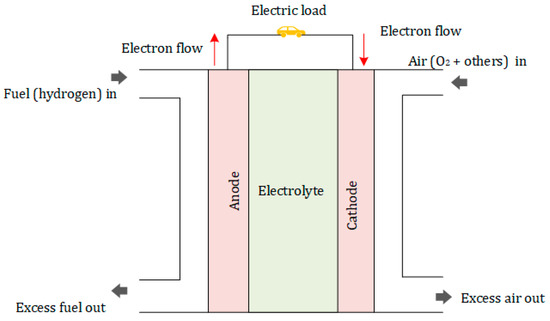
Figure 14.
Model of a fuel cell.
Table 8 compares key features of different classes of energy resources that are involved in EV applications.

Table 8.
Comparison of key features of energy resources used in EV applications.
4. Future Outlook and Insight
In this section, we discuss the future prospects of EV infrastructure and the expected growth towards transportation electrification and several governments’ plan of climate action.
Battery costs can form up to a third of the total cost of an EV [6]. However, the cost of batteries has been steadily reducing as more research and innovation have progressed. Battery pack prices reduced by 89% between 2010 and 2021 to an average of 132 USD/kWh [86,87]. Global vehicle manufacturers are also investing more in solid-state battery technologies, which could further reduce the cost of battery packs in the coming years. Nissan is currently planning to unveil a solid-state battery EV by 2028 [86].
With a growth rate of 20.2%, battery swapping infrastructure could reach a market value of USD 811.5 million by 2030 [61]. The expansion of the hugely successful Chinese company Nio is a huge boost in this sector. Nio is currently launching in Germany, the Netherlands, Sweden, Norway, and Denmark, and plans to launch in the U.S. market by 2025 [58]. The expansion of the US startup Ample is also an encouraging sight for this sector.
Hydrogen refueling infrastructure availability is currently on the ascendancy, with the Asian market leading the way. The H2ME of European countries could prove vital in the expansion of hydrogen refueling infrastructure for the higher adoption of EVs. Data from [65] suggest several stations are under construction worldwide. It is, therefore, expected that the number of refueling hydrogen stations will continue to increase, making the penetration and adoption FCEVs easier and faster.
China continues to dominate the world in the number of publicly accessible chargers. It has around 85% of the fast chargers and 55% of the slow chargers on the entire planet. This reflects both China’s established leadership in the EV market and the country’s characteristically densely populated metropolitan cities [64]. It is expected that China will continue to lead in this regard over the next years. However, policies such us the US infrastructure bill would significantly improve the charging infrastructure in the US by providing 500,000 public chargers by 2030 [11]. In addition, the aim of the US government of having 100 percent zero-emission vehicles by 2035 provides further optimism towards transportation electrification and climate action [88].
The commitment of more countries towards infrastructure development provides optimism towards EV adoption in the world’s attempt to combat greenhouse emissions and climate change.
5. Conclusions
In this work, a review of the main problems that affect electric vehicle adoption, which are charging infrastructure availability and energy resources, is presented. We discuss various charging infrastructure types based on the location-of-charge and the charging technology. An expansive review of these infrastructures is presented together with an outlook into their future. In addition, a review of the energy resources required for electric vehicles is also presented. The key features of energy resources (batteries and fuel cells) that affect their performance are presented. This work provides information that could benefit other researchers interested in electric vehicle charging infrastructures and their development.
Author Contributions
Conceptualization, P.A. and A.S.A.-S.; methodology, P.A.; formal analysis, P.A.; investigation, P.A. and A.S.A.-S.; resources, A.S.A.-S. and K.H.A.-H.; writing—original draft preparation, P.A.; writing—review and editing, P.A. and A.S.A.-S.; supervision, A.S.A.-S. and K.H.A.-H.; funding acquisition, A.S.A.-S. and K.H.A.-H. All authors have read and agreed to the published version of the manuscript.
Funding
This work is supported by Khalifa University as part of KKJRC-2019-Trans 2 and the Virtual Research Institute (VRI) program, Award Number VRI20-07.
Data Availability Statement
All data used in this research have been cited in the references.
Acknowledgments
This is to acknowledge the value of NEP 3.0 in supporting the leadership of the second author.
Conflicts of Interest
The authors declare no conflict of interest.
References
- Yang, C.; Lou, L.; Yao, J.; Xie, S. On charging scheduling optimization for a wirelessly charged electric bus system. IEEE Trans. Intell. Transp. Syst. 2018, 19, 1814–1826. [Google Scholar] [CrossRef]
- Li, C.; Cao, Y.; Zhang, M.; Wang, J.; Liu, J.; Shi, H.; Geng, Y. Hidden benefits of electric vehicles for addressing climate change. Sci. Rep. 2015, 5, 9213. [Google Scholar] [CrossRef] [PubMed]
- Barkenbus, J. Our electric automotive future: Co2 savings through a disruptive technology. Policy Soc. 2009, 27, 399–410. [Google Scholar] [CrossRef]
- Miller, M.J.; Onar, C.O.; Chinthavali, M. Primary-side power flow control of wireless power transfer for electric vehicle charging. IEEE J. Emerg. Sel. Top. Power Electron. 2015, 3, 147–162. [Google Scholar] [CrossRef]
- Fuji-Keizai. Country-Specific Development and Dissemination Plan for Ev/Phev Charging Infrastructure. Available online: https://www.fuji-alman.co.jp/report/detail.html?code=162110917 (accessed on 23 March 2022).
- Jang, J.Y.; Suh, S.E.; Kim, W.K. System architecture and mathematical models of electric transit bus system utilizing wireless power transfer technology. IEEE Syst. J. 2015, 10, 495–506. [Google Scholar] [CrossRef]
- Bullis, K. MIT Technology Review: A Big Jump in Battery Capacity. Available online: https://www.technologyreview.com/2012/03/01/187319/a-big-jump-in-battery-capacity/ (accessed on 12 March 2022).
- McDonald, L. Why Do So Many Us Drivers Want at Least 300 Milesof Range before Considering the Purchase of an Electric Vehicle. Available online: https://evadoption.com/why-do-so-many-us-drivers-want-at-least-300-miles-of-range-before-considering-the-purchase-of-an-electric-vehicle/ (accessed on 3 December 2021).
- Jang, J.Y.; Jeong, S.; Lee, S.M. Initial energy logistics cost analysis for stationary, quasi-dynamic, and dynamic wireless charging public transportation systems. Energies 2016, 9, 483. [Google Scholar] [CrossRef]
- Figenbaum, E.; Kolbenstvedt, M. Electromobility in Norway—Experiences and Opportunities with Electric Vehicles. Norwegian Centre for Transport Research. TØI Report: 1281/2013. 2013; p. 170. Available online: https://www.toi.no/getfile.php?mmfileid=33828 (accessed on 24 January 2023).
- Kampshoff, P.; Kumar, A.; Peloquin, S.; Sahdev, S. Building the Electric-Vehicle Charging Infrastructure America Needs. Available online: https://www.mckinsey.com/industries/public-and-social-sector/our-insights/building-the-electric-vehicle-charging-infrastructure-america-needs. (accessed on 24 January 2023).
- IEA. World Energy Outlook 2021. Available online: https://www.iea.org/reports/world-energy-outlook-2021 (accessed on 24 October 2021).
- Yong, Y.J.; Ramachandaramurthy, K.V.; Tan, M.K.; Mithulananthan, N. A review on the state-of-the-art technologies of electric vehicle, its impacts and prospects. Renew. Sustain. Energy Rev. 2015, 49, 365–385. [Google Scholar] [CrossRef]
- US Department of Energy. Fuels and Vehicles. Available online: https://afdc.energy.gov/ (accessed on 24 January 2023).
- Un-Noor, F.; Padmanaban, S.; Mihet-Popa, L.; Mollah, M.N.; Hossain, E. A comprehensive study of key electric vehicle (ev) components, technologies, challenges, impacts, and future direction of development. Energies 2017, 10, 1217. [Google Scholar] [CrossRef]
- EPA. Explaining Electric & Plug-In Hybrid Electric Vehicles. Available online: https://www.epa.gov/greenvehicles/explaining-electric-plug-hybrid-electric-vehicles (accessed on 23 January 2023).
- US Department of Energy. Developing Infrastructure to Charge Electric Vehicles. Available online: https://afdc.energy.gov/fuels/electricity_infrastructure.html (accessed on 23 January 2023).
- IEA. Hydrogen. Available online: https://www.iea.org/reports/hydrogen (accessed on 25 January 2023).
- Plugless Power. Ev Unplugged. Available online: https://www.pluglesspower.com/ (accessed on 5 May 2022).
- Tesla. Introducing v3 Supercharging. Available online: https://www.tesla.com/blog/introducing-v3-supercharging (accessed on 5 April 2022).
- Gaton, B. What Is CCS Charging? Available online: https://thedriven.io/2018/12/10/what-is-ccs-charging/ (accessed on 2 February 2022).
- EV Safe Charge Inc. What Is DC Fast Charging? Available online: https://evsafecharge.com/dc-fast-charging-explained/ (accessed on 7 April 2022).
- EVExpert. Connector Types for EV Charging around the World. Available online: https://www.evexpert.eu/eshop1/knowledge-center/connector-types-for-ev-charging-around-the-world (accessed on 23 January 2023).
- Bower, G. Electric Vehicle Charging Levels Explained. Available online: https://insideevs.com/news/328781/electric-vehicle-charging-levels- (accessed on 7 April 2022).
- Moloughney, T. What are the Different Levels of Electric Vehicle Charging? Available online: https://www.forbes.com/wheels/advice/ev-charging-levels/ (accessed on 20 January 2022).
- Dalroad. An Introduction to Electric Vehicle Rapid Charging Standards. Available online: https://www.dalroad.com/resources/an-introduction-to-electric-vehicle-rapid-charging-standards/ (accessed on 12 November 2021).
- 2IEA. Global EV Outlook 2022. Available online: https://www.iea.org/reports/global-ev-outlook-2022 (accessed on 21 January 2023).
- Zhao, J.; Cai, T.; Duan, S.; Feng, H.; Chen, C.; Zhang, X. A general design method of primary compensation network for dynamic wpt system maintaining stable transmission power. IEEE Trans. Power Electron. 2016, 31, 8343–8358. [Google Scholar] [CrossRef]
- Ahmad, A.; Alam, M.S.; Chabaan, R. A comprehensive review of wireless charging technologies for electric vehicles. IEEE Trans. Transp. Electr. 2018, 4, 38–63. [Google Scholar] [CrossRef]
- Nguyen, H.T.; Alsawalhi, J.Y.; Al Hosani, K.; Al-Sumaiti, A.S.; Al Jaafari, K.A.; Byon, Y.-J.; El Moursi, M.S. Review map of comparative designs for wireless high-power transfer systems in ev applications: Maximum efficiency, zpa, and cc/cv modes at fixed resonance frequency independent from coupling coefficient. IEEE Trans. Power Electron. 2022, 37, 4857–4876. [Google Scholar] [CrossRef]
- Shaikh, P.W.; Mouftah, H.T. Intelligent charging infrastructure design for connected and autonomous electric vehicles in smart cities. In Proceedings of the 2021 IFIP/IEEE International Symposium on Integrated Network Management (IM), Bordeaux, France, 18–20 May 2021; pp. 992–997. [Google Scholar]
- Lukic, S.; Pantic, Z. Cutting the cord: Static and dynamic inductive wireless charging of electric vehicles. IEEE Electr. Mag. 2013, 1, 57–64. [Google Scholar] [CrossRef]
- Bhattacharya, S.; Tan, Y.K. Design of static wireless charging coils for integration into electric vehicle. In Proceedings of the 2012 IEEE Third International Conference on Sustainable Energy Technologies (ICSET), Kathmandu, Nepal, 24–27 September 2012; pp. 146–151. [Google Scholar] [CrossRef]
- Chen, W.; Liu, C.; Lee, C.H.T.; Shan, Z. Cost-Effectiveness Comparison of Coupler Designs of Wireless Power Transfer for Electric Vehicle Dynamic Charging. Energies 2016, 9, 906. [Google Scholar] [CrossRef]
- Mohamed, A.A.; Lashway, R.C.; Mohammed, O. Modeling and feasibility analysis of quasi-dynamic wpt system for ev ap-plications. IEEE Trans. Transp. Electr. 2017, 3, 343–353. [Google Scholar] [CrossRef]
- Mi, C.C.; Buja, G.; Choi, Y.S.; Rim, T.C. Modern advances in wireless power transfer systems for roadway powered electric vehicles. IEEE Trans. Ind. Electron. 2016, 63, 6533–6545. [Google Scholar] [CrossRef]
- Jeong, S.; Jang, J.Y.; Kum, K. Economic analysis of the dynamic charging electric vehicle. IEEE Trans. Power Electron. 2015, 30, 6368–6377. [Google Scholar] [CrossRef]
- Electreon. A Milestone in Urban Wireless Electric Road Systems. Available online: https://electreon.com/projects/tel-aviv (accessed on 2 June 2022).
- NDUCTEV. Powering the Commercial Fleets of the Future. Available online: https://inductev.com/#wirelesscharging (accessed on 28 January 2023).
- Mahesh, A.; Chokkalingam, B.; Mihet-Popa, L. Inductive wireless power transfer charging for electric vehicles—A review. IEEE Access 2021, 9, 137667–137713. [Google Scholar] [CrossRef]
- Zhang, S.; Gajpal, Y.; Appadoo, S.; Abdulkader, M. Electric vehicle routing problem with recharging stations for minimizing energy consumption. Int. J. Prod. Econ. 2018, 203, 404–413. [Google Scholar] [CrossRef]
- Mehar, S.; Senouci, M.S. An optimization location scheme for electric charging stations. In Proceedings of the 2013 International Conference on Smart Communications in Network Technologies (SaCoNeT), Paris, France, 17–19 June 2013; pp. 1–5. [Google Scholar] [CrossRef]
- Mouhrim, N.; El Hilali Alaoui, A.; Boukachour, J. Pareto efficient allocation of an in-motion wireless charging infrastructure for electric vehicles in a multipath network. Int. J. Sustain. Transp. 2019, 13, 419–432. [Google Scholar] [CrossRef]
- Şengör, İ.; Erenoğlu, A.K.; Erdinç, O.; Taşcıkaraoğlu, A.; Taştan, İ.C.; Büyük, A.F. Optimal sizing and siting of ev charging stations in a real distribution system environment. In Proceedings of the 2020 International Conference on Smart Energy Systems and Technologies (SEST), Istanbul, Turkey, 7–9 September 2020; pp. 1–6. [Google Scholar] [CrossRef]
- Aggarwal, S.; Singh, K.A. Impact analysis of electric vehicle charging station integration with distributed generators on power systems. Int. J. Circuit Theory Appl. 2021, 49, 1811–1827. [Google Scholar] [CrossRef]
- Alwesabi, Y.; Wang, Y.; Avalos, R.; Liu, Z. Electric bus scheduling under single depot dynamic wireless charging infrastructure planning. Energy 2020, 213, 118855. [Google Scholar] [CrossRef]
- Kosmanos, D.; Maglaras, L.A.; Mavrovouniotis, M.; Moschoyiannis, S.; Argyriou, A.; Maglaras, A.; Janicke, H. Route optimization of electric vehicles based on dynamic wireless charging. IEEE Access 2018, 6, 42551–42565. [Google Scholar] [CrossRef]
- Zhang, S.; James, J. Electric vehicle dynamic wireless charging system: Optimal placement and vehicle-to-grid scheduling. IEEE Internet Things J. 2022, 9, 6047–6057. [Google Scholar] [CrossRef]
- Erdinc, O.; Tascikaraoglu, A.; Paterakis, N.G.; Dursun, I.; Sinim, M.C.; Catalão, J.P. Optimal sizing and siting of dis-tributed generation and EV charging stations in distribution systems. In Proceedings of the 2017 IEEE PES Innovative Smart Grid Technologies Conference Europe (ISGT-Europe), Turin, Italy, 26–29 September 2017; pp. 1–6. [Google Scholar] [CrossRef]
- Jin, Y.; Xu, J.; Wu, S.; Xu, L.; Yang, D. Enabling the wireless charging via bus network: Route scheduling for electric vehicles. IEEE Trans. Int. Trans. Syst. 2021, 22, 1827–1839. [Google Scholar] [CrossRef]
- Bozorgi, A.M.; Farasat, M.; Mahmoud, A.A. Time and energy efficient routing algorithm for electric vehicles based on historical driving data. IEEE Trans. Intel. Veh. 2017, 2, 308–320. [Google Scholar] [CrossRef]
- Kyriakakis, N.A.; Stamadianos, T.; Marinaki, M.; Marinakis, Y. The electric vehicle routing problem with drones: An energy minimization approach for aerial deliveries. Clean. Logist. Supply Chain 2022, 4, 100041. [Google Scholar] [CrossRef]
- Alamatsaz, K.; Hussain, S.; Lai, C.; Eicker, U. Electric Bus Scheduling and Timetabling, Fast Charging Infrastructure Planning, and Their Impact on the Grid: A Review. Energies 2022, 15, 7919. [Google Scholar] [CrossRef]
- Cao, Y.; Kaiwartya, O.; Zhuang, Y.; Ahmad, N.; Sun, Y.; Lloret, J. A decentralized deadline-driven electric vehicle charging recommendation. IEEE Syst. J. 2019, 13, 3410–3421. [Google Scholar] [CrossRef]
- Cao, Y.; Kaiwartya, O.; Wang, R.; Jiang, T.; Aslam, N.; Sexton, G. Toward efficient, scalable, and coordinated on-the-move EV charging management. IEEE Wirel. Commun. 2017, 24, 66–73. [Google Scholar] [CrossRef]
- Machura, P.; Li, Q. A critical review on wireless charging for electric vehicles. Renew. Sustain. Energy Rev. 2019, 104, 209–234. [Google Scholar] [CrossRef]
- Li, S.; Mi, C.C. Wireless power transfer for electric vehicle applications. IEEE J. Emerg. Sel. Top. Power Electron. 2015, 3, 4–17. [Google Scholar] [CrossRef]
- Winton, N. Battery-Swapping Revival Could Threaten Electric Car Charging Networks. Available online: https://www.forbes.com/sites/neilwinton/2022/09/12/battery-swapping-revival-could-threaten-electric-car-charging-networks/ (accessed on 22 January 2023).
- The Tesla Team. Battery Swap Pilot Program. Available online: https://www.tesla.com/blog/battery-swap-pilot-program (accessed on 27 January 2023).
- Revankar, S. Tesla Battery Swap Station: What Happened to Elon’s Claim on Fully Charging Tesla in 90 Seconds? Available online: https://www.vehiclesuggest.com/what-happened-tesla-battery-swap/ (accessed on 27 January 2023).
- Grand View Research. Battery Swapping Charging Infrastructure Market Size, Share & Trends Analysis Report By Vehicle Type (Three-, Two-Wheeler), by Service Type (Pay-per-Use, Subscription), by Region, and Segment Forecasts, 2022–2030. Available online: https://www.grandviewresearch.com/industry-analysis/battery-swapping-charging-infrastructure-market-report (accessed on 24 January 2023).
- Bellan, R. Ample’s Co-Founder Explains What It Takes to Scale EV Battery Swapping. Available online: https://techcrunch.com/2022/12/28/amples-founder-explains-what-it-takes-to-scale-ev-battery-swapping/ (accessed on 26 January 2023).
- Lienert, P.; Carey, N.; Shirouzu, N. Inside China’s Electric Drive for Swappable Car Batteries. Available online: https://www.reuters.com/business/autos-transportation/inside-chinas-electric-drive-swappable-car-batteries-2022-03-24/ (accessed on 21 January 2023).
- Hydrogen Mobility Europe. Hydrogen Refuelling Infrastructure. Available online: https://h2me.eu/about/hydrogen-refuelling-infrastructure/ (accessed on 22 January 2023).
- H2Stations. 14th Annual Assessment. Available online: https://www.h2stations.org (accessed on 27 January 2023).
- Fan, X.; Liu, B.; Liu, J.; Ding, J.; Han, X.; Deng, Y.; Lv, X.; Xie, Y.; Chen, B.; Hu, W.; et al. Battery technologies for grid-level large-scale electrical energy storage. Trans. Tianjin Univ. 2020, 26, 92–103. [Google Scholar] [CrossRef]
- Bukhari, S.M.A.S.; Maqsood, J.; Baig, M.Q.; Ashraf, S.; Khan, T.A. Comparison of Characteristics—Lead Acid, Nickel Based, Lead Crystal and Lithium Based Batteries. In Proceedings of the 2015 17th UKSim-AMSS International Conference on Modelling and Simulation (UKSim), Cambridge, UK, 25–27 March 2015; pp. 444–450. [Google Scholar] [CrossRef]
- Vidyanandan, K.V. Batteries for Electric Vehicles. Energy Scan 2019, 1, 1–7. [Google Scholar]
- Power Me UP. Eneloop XX vs. Turnigy 2400 Cycle Testing. Available online: https://www.candlepowerforums.com/threads/eneloop-xx-vs-turnigy-2400-cycle-testing.391756/ (accessed on 23 November 2022).
- EneloopProduct Lineup. Panasonic.net. Available online: https://web.archive.org/web/20140203082140/http://panasonic.net/energy/battery/eneloop/lineup/ (accessed on 10 November 2022).
- Battery University. BU-203: Nickel Based Batteries. Available online: https://batteryuniversity.com/article/bu-203-nickel-based-batteries (accessed on 11 November 2022).
- May, G.J.; Davidson, A.; Monahov, B. Lead batteries for utility energy storage: A review. J. Energy Storage 2018, 15, 145–157. [Google Scholar] [CrossRef]
- Szałek, A.; Pielecha, I.; Cieslik, W. Fuel Cell Electric Vehicle (FCEV) Energy Flow Analysis in Real Driving Conditions (RDC). Energies 2021, 14, 5018. [Google Scholar] [CrossRef]
- Du, Z.; Liu, C.; Zhai, J.; Guo, X.; Xiong, Y.; Su, W.; He, G. A Review of Hydrogen Purification Technologies for Fuel Cell Ve-hicles. Catalysts 2021, 11, 393. [Google Scholar] [CrossRef]
- Akinyele, D.; Olabode, E.; Amole, A. Review of Fuel Cell Technologies and Applications for Sustainable Microgrid Systems. Inventions 2020, 5, 42. [Google Scholar] [CrossRef]
- Nerad, J.R. How a Fuel Cell Vehicle Works. Available online: https://www.jdpower.com/cars/shopping-guides/how-a-fuel-cell-vehicle-works (accessed on 25 January 2023).
- PowerPSSonic. Lead Acid Batteries. Available online: https://www.power-sonic.com/batteries/sealed-lead-acid/ (accessed on 10 September 2022).
- Powersonic Batteries. Technical Manual: Sealed Lead Acid Batteries. Available online: http://www.ken-lab.com/uploads/6/6/1/3/66134969/powersonicmanual.pdf (accessed on 25 May 2022).
- Crompton, T.R. Battery Reference Book, 3rd ed.; Newnes: Woburn, MA, USA, 2000; pp. 1–10. ISBN 07506-4625-X. [Google Scholar]
- Redondo-Iglesias, E.; Venet, P.; Pelissier, S. Measuring Reversible and Irreversible Capacity Losses on Lithium-Ion Batteries. In Proceedings of the 2016 IEEE Vehicle Power and Propulsion Conference (VPPC), Hangzhou, China, 17–20 October 2016; pp. 1–7. [Google Scholar] [CrossRef]
- Valøen, L.O.; Shoesmith, M.I. The effect of PHEV and HEV duty cycles on battery and battery pack performance. In Proceedings of the 2007 Plug-in Highway Electric Vehicle Conference, Winnipeg, MB, Canada, 1–2 November 2007; pp. 4–5. [Google Scholar]
- PowerStream. NiMH Battery Charging Basics. Available online: https://www.powerstream.com/NiMH.htm (accessed on 5 August 2022).
- Zhu, W.; Zhu, Y.; Davis, Z.; Tatarchuk, B. Energy efficiency and capacity retention of Ni–MH batteries for storage applications. Appl. Energy 2013, 106, 307–313. [Google Scholar] [CrossRef]
- Sabihuddin, S.; Kiprakis, A.E.; Mueller, M. A numerical and graphical review of energy storage technologies. Energies 2015, 8, 172–216. [Google Scholar] [CrossRef]
- Kirubakaran, A.; Jain, S.; Nema, R.K. A review on fuel cell technologies and power electronic interface. Renew. Sustain. Energy Rev. 2009, 13, 2430–2440. [Google Scholar] [CrossRef]
- Edison Electric Institute. Electric Vehicle Sales and the Charging Infrastructure Required Through 2030. Available online: https://www.eei.org/-/media/Project/EEI/Documents/Issues-and-Policy/Electric-Transportation/EV-Forecast--Infrastructure-Report.pdf (accessed on 30 January 2023).
- BloombergNEF. Battery Pack Prices Fall to an Average of $132/kWh, But Rising Commodity Prices Start to Bite. Available online: https://about.bnef.com/blog/battery-pack-prices-fall-to-an-average-of-132-kwh-but-rising-commodity-prices-start-to-bite/ (accessed on 30 January 2023).
- White House. FACT SHEET: President Biden Signs Executive Order Catalyzing America’s Clean Energy Economy Through Federal Sus-tainability. Available online: https://www.whitehouse.gov/briefing-room/statements-releases/2021/12/08/fact-sheet-president-biden-signs-executive-order-catalyzing-americas-clean-energy-economy-through-federal-sustainability/ (accessed on 27 January 2023).
Disclaimer/Publisher’s Note: The statements, opinions and data contained in all publications are solely those of the individual author(s) and contributor(s) and not of MDPI and/or the editor(s). MDPI and/or the editor(s) disclaim responsibility for any injury to people or property resulting from any ideas, methods, instructions or products referred to in the content. |
© 2023 by the authors. Licensee MDPI, Basel, Switzerland. This article is an open access article distributed under the terms and conditions of the Creative Commons Attribution (CC BY) license (https://creativecommons.org/licenses/by/4.0/).